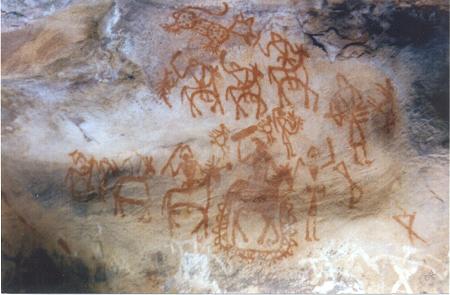
Travel India Bhimbetka Caves
Earliest Human Settlements in India
The Bhimbetka Caves, or Bhimbetka Rock Shelters, (also known as ‘Bhim Baithaka’ meaning Bhim’s seat), located at the southern edge of the Vindhyachal Hills, 45 km south of Bhopal in Madhya Pradesh, contain 15,000 year old Stone Age rock paintings – the earliest evidences of human life in India.The rock paintings, which are in remarkably good condition even today, take us on a journey into time and tell us about the lifestyle of our ancestors over a period spanning thousands of years.
Mythology
According to mythology, when the five Pandavas were banished from their kingdom, they came and stayed here in these caves. They even built a palace at Lakhajuhar made out of lac.
Bhima used the massive rocks for sitting. This is why the place is also called ‘Bhim Baithaka’.
Based on information gathered from local adivasis (tribals), Bhimbetka was first mentioned in Indian archeological records in 1888 as a Buddhist site.
In 1957, Dr. V. S. Wakankar, an archaeologist from Vikram University, Ujjain stumbled upon these rock formations. They were similar to those he had seen in Spain and France.
Archaeological excavations over the next 16 years yielded more than 700 such shelters dating from the Lower Palaeolithic Age to the Early Medieval Age.
The site spread over 10 kms in length and about 3 kms in width has more than 700 rock shelters, of which more than 400 have paintings. But only about a dozen caves are open to tourists.
Rock Art and Paintings
The rock shelters and caves of Bhimbetka have a large number of interesting paintings which depict the lives and times of the people who lived in the caves, including depictions of animals, communal dancing and drinking, birth, death and religious rites.
A broad chronology of the finds has been done, but a detailed chronology is yet to be created.
The paintings have been done mainly in red and white with occasional use of green and yellow.
We get an insight of the life style during those days.

The stylised figures show linear decorations on the body.
In addition to animals, there are human figures and hunting scenes, giving a clear picture of the weapons used – barbed spears, pointed sticks, bows and arrows.
There are depictions of birds, animals, drinking, musical instruments, communal dances, pregnant women, mother and child, and men carrying dead.
The figures of this group have a schematic and decorative style and are painted mainly in red, white and rarely green.
There is association of riders, depiction of religious symbols, Tunic-like dresses and scripts of different periods.
Period V – (Medieval): These paintings are geometric, linear and more schematic, but show degeneration and crudeness in their artistic style.
For the first time, we find paintings of the Brahmanical Hindu Gods like Ganesh and Natraja in these rock shelters.
The cave dwellers prepared the pigments they used by combining manganese, haematite, soft red stone, wood coal and plants. They made brushes out of pieces of fibrous plants.
The caves vary in sizes.
Some are very small while some can accommodate 100 people.
One cave resembles the shape of a tortoise and the entrance resembles the mouth of a snake.You must visit the Zoo Rock Cave, which is the most famous of the caves.
These rocks have painting as old as 10,000 B.C. depicting various animals like elephants, antelopes and horses.You must visit Barkhera (7 kms from Bhimbetka).
This is Richest Open Air Stone Age Site in South Asia.
You can see Thousands of Acheulian Tools Scattered in the dense teak forest.
How to Reach
Bhopal (45 Kms from Bhimbetka) is the nearest airport having direct flights from Mumbai, Delhi, Indore and Gwalior.
Rail
Bhopal has a railway station with trains from Chennai, Delhi and Mumbai.
Road Bhimbetka is situated on the Bhopal-Hoshangabad National Highway No. 69.
It is well connected by good roads.
Best Season
July to March.
Nature has carefully preserved these clusters of natural rock shelters within massive outcrops of sandstone, above dense forests.
The Bhimbetka Rock Shelters are unique because the paintings and tools allow us to see the pattern of life over thousands of years.
They show the gradual transformation of man from a cave dweller to agriculturist and trader.
They also graphically depict the evolution of tools.
The Bhimbetka Rock Shelters were recognized as a World Heritage Site in 2002.
You can see more details and information at the following site:
http://asi.nic.in/asi_monu_whs_rockart_bhimbetka.asp


pictures of nordegren woods
Incredible site!
kopy cat recipes
<a href= http
If you have to do it, you might as well do it right
Great site. Good info
??????????????. ?????????????????????????.
viagra
Excellent site. It was pleasant to me.
Excellent site. It was pleasant to me.
Very interesting site. Hope it will always be alive!
I bookmarked this site. Thank you for good job!
xanax
<a href= http://megynkellyengageddoug.hanopak
I bookmarked this site. Thank you for good job!
tramadol